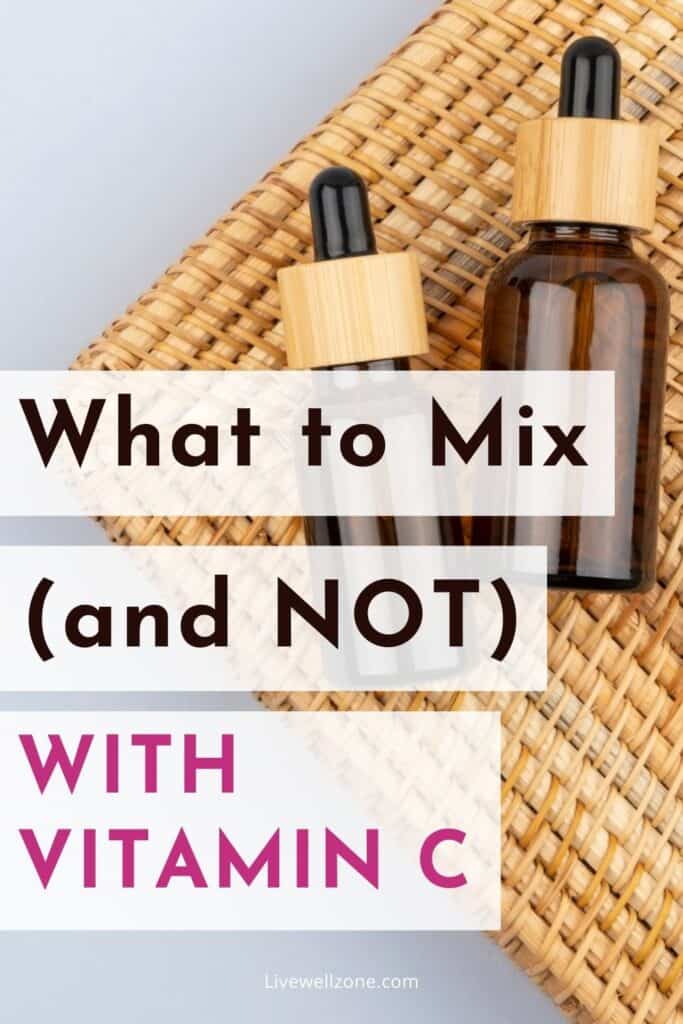
With so many skin care products to choose from, knowing what to mix with vitamin C serum (and what to avoid) can be confusing.
That’s why this guide walks you through how to incorporate vitamin C and other ingredients into your skin care routine (so that you get max results while protecting your skin!).
Let’s get right to it!
Note: this post contains affiliate links and I earn a commission (at no additional cost to you) if you use them to make a purchase.
| INGREDIENT | HOW TO USE |
|---|---|
| Hyaluronic acid | layer or use in an all-in-one formula. |
| Other antioxidants | layer or use in an all-in-one formula. |
| Moisturizer | apply moisturizer after serum. |
| Rosehip oil (and other carrier oils) | apply oil after serum. |
| Sunscreen | apply sunscreen as last step in your routine. |
| Aloe vera | apply aloe gel first, followed by vitamin C serum. |
| Alpha and Beta Hydroxy acids | avoid layering; use at separate times of the day or buy a formula made with both. |
| Benzoyl peroxide | avoid layering; use at separate times of the day. |
| Niacinamide | layer or buy a formula made with both. |
| Retinol | avoid layering; use at separate times of the day or alternate days; buy a formula made with both. |
WHAT TO MIX VITAMIN C SERUM WITH

1. Hyaluronic Acid
Hyaluronic acid (HA) and vitamin C are a good combination because hyaluronic acid’s anti-inflammatory and humectant (i.e. water attracting) properties can help offset the dryness that sometimes occurs with vitamin C.
In addition, vitamin C provides antioxidant and collagen-boosting properties, while hyaluronic acid helps to temporarily plump the skin and give it a smoother appearance.
How to use hyaluronic acid and vitamin C together
The easiest way to get the benefits of hyaluronic acid and vitamin C is to use a product that is formulated with both.
However, if you’re using separate products, then start by checking their consistencies. Apply the thinner or water-based product first, followed by the heavier product.
For example:
- If you’re using a hyaluronic acid serum and vitamin C moisturizer, the hyaluronic serum should be applied first.
- On the other hand, if you’re using a vitamin C serum and a hyaluronic moisturizer, then the vitamin C serum should be applied first.
2. Other Antioxidants (such as vitamin E and ferulic acid)
Vitamin C has been shown to work quite well with vitamin E and ferulic acid, which are both antioxidants.
There are two main benefits to pairing vitamin C with these ingredients (source).
- Vitamin E and ferulic acid help to stabilize vitamin C so that it doesn’t degrade as quickly as it normally would.
- Ferulic acid has been shown to double the photoprotective properties of vitamin C and E (when both vitamins are used together).
How to use vitamin C with antioxidants like vitamin E and ferulic acid
There are more and more products on the market that combine vitamin C with one or both of these ingredients, such as:
- Mad Hippie Vitamin C Serum (includes vitamin E and ferulic).
- Naturium Vitamin C Complex Serum (includes vitamin E and ferulic).
- InstaNatural Vitamin C Serum (includes ferulic acid).
3. Moisturizer
Whether your moisturizer of choice is a lotion, cream or oil (technically more of a sealant than a moisturizer), it’s a good match for vitamin C serums.
All skin types can benefit from this combination, but particularly those with dry or sensitive skin.
Since serums usually have a thinner consistency and also contain active ingredients that can be irritating, a moisturizer helps to bring balance to the skin.
How to combine vitamin C serum with moisturizer
Apply the serum first, followed by the moisturizer.
4. Rosehip Oil
Like all carrier oils, rosehip oil is great for locking in the moisture from your vitamin C serum.
In addition, rosehip oil is naturally rich in fatty acids and beta-carotene.
That beta carotene is converted to retinyl esters (aka preformed vitamin A, which is the same category that retinol belongs to. Same category but not the same thing 🙂 ).
Now, one final thing to keep in mind is that even though rosehips are rich in vitamin C, rosehip oil is not.
This is because vitamin C is water-soluble and therefore, you won’t find it in oils.
So, you don’t have to worry about overloading on vitamin C when you use rosehip oil and vitamin C serum.
How to mix rosehip oil and vitamin C serum
Apply rosehip oil after vitamin C serum.
5. Aloe Vera Gel
Aloe vera and vitamin C complement each other because aloe is very hydrating and also has humectant properties that draw moisture to the skin.
So, if your skin tends to get dried out by vitamin C, pairing it with aloe can be helpful.
In addition, aloe is very soothing to sensitive or inflamed skin.
As for vitamin C it has been shown to improve redness in rosacea patients when used at a concentration of 5% (source).
So, paired together, these ingredients can be quite soothing for inflamed skin.
How to use aloe vera and vitamin C
- Buy a product that includes both ingredients.
- Layer them by applying aloe vera gel first, followed by vitamin c serum.
- Make your own vitamin c serum with aloe vera. Here’s a quick tutorial:
6. Sunscreen
When used on it’s own, vitamin C’s antioxidant properties are known for protecting the skin from free radical damage (a lot of which occurs from environmental factors like pollution, and yes, the sun). However, by combining vitamin C and sunscreen, your skin can get even more sun protection.
Here’s why…
- Sunscreens block about 55% of the free radicals that are produced after exposure to UV light.
- Vitamin C neutralizes free radicals.
According to this study, using sunscreen and 10% vitamin C results in a 52% reduction in redness and a 40-60% reduction in the development of sunburn cells.
How to use vitamin C serum and sunscreen
- Apply sunscreen as the final step in your routine (before makeup).
- Consider using a vitamin C serum that has vitamin E and ferulic. Both of these will further boost vitamin C’s benefits.
WHAT NOT TO MIX WITH VITAMIN C FOR SKIN CARE
1. Alpha Hydroxy and Beta Hydroxy Acids
Ingredients like salicylic acid, glycolic acid and lactic acid can change the pH of your vitamin C product, essentially making it less effective.
So, rather than layer these ingredients, it’s best to use them at separate times.
Now, having said that, you may be thinking “why do some brands sell products that contain vitamin C and AHAs or BHAs?”
It’s important to remember that those products are specially formulated for everything to work together, at the proper pH.
It’s a different scenario from layering individual products at home.
2. Benzoyl Peroxide
Benzoyl peroxide can potentially oxidize vitamin C and subsequently, make vitamin C less effective.
To avoid this, use them at separate times or days in your routine.
CAN I MIX NIACINAMIDE WITH VITAMIN C?
Although it was once believed that niacinamide and vitamin C are a no-no combination, the truth is that they can be used together…under the right circumstances!
In order to understand how to use them together, let’s quickly look at why pairing them used to be frowned upon.
It all stems from old research showing that vitamin C and niacinamide produced nicotinic acid (which is a skin irritant).
However, that study used pure ascorbic acid (which is notoriously unstable) and niacinamide at high temperatures.
Nowadays, we have more stable forms of vitamin C that minimize the concerns about a bad interaction with niacinamide.
Furthermore, the temperatures in which most people live is not as high as the temperature used in that study. Since high temperature is required to produce nicotinic acid, this outcome is less likely to happen in real life.
Tips for combining vitamin C and niacinamide
- You can either use a product that is formulated with both ingredients or you can layer separate products.
- If you go with the layering option, just follow the basic rules of layering and apply the heavier or oil-based product last.
- Lastly, if you’re still worried about the potential production of nicotinic acid, use a vitamin C derivative. The derivatives are gentler on the skin (and also, more stable than ascorbic acid). Examples of these derivatives include sodium ascorbyl phosphate, magnesium ascorbyl phosphate or tetrahexyldecyl ascorbate.
CAN YOU MIX VITAMIN C AND RETINOL TOGETHER?
When it comes to combining vitamin C and retinol, the main thing to know is that layering them could cause serious irritation. So, rather than layer them, follow these basic guidelines:
- Use vitamin C and retinol at different times of the day (or even on alternate days). This will help reduce irritation. In general, vitamin C is suitable for the daytime while retinol is better at night.
- If you want to use them together, do a patch test first. If your skin is happy with the combination, then you can use them together. In fact, some research shows that combining antioxidants – such as vitamin C – with retinoids, could actually boost the antioxidant’s protective properties.
- Another option for using vitamin C and retinol together is to buy a product that is formulated with both (like this Naturium Vitamin C Super Serum Plus). An all–in-one formula simplifies things because the pH of the formula has been optimized for your skin and for the individual ingredients. It’s a safer option than layering separate products (though it’s still not a guarantee that your skin will like the combination).

By the way, you can download this free cheatsheet with all of the info from this article (no email required).
FAQs ABOUT WHAT YOU CAN AND CANNOT COMBINE WITH VITAMIN C SERUM
Can I mix vitamin C with other serums?
Vitamin C serum can be used with other serums, as long as they don’t contain ingredients that shouldn’t be combined with vitamin C (such as AHAs and BHAs). Since vitamin C is considered a treatment serum, it’s best combined with a hydrating serum that has ingredients like hyaluronic acid.
Also, keep in mind that when layering serums, you should apply the one that is most important for your skin first.
So, if your primary goal is to improve hyperpigmentation, apply your vitamin C serum first, then any other serum you have.
On the other hand, if hydration is your primary goal, then apply your hydrating serum first.
Can I use vitamin C in the morning and retinol at night?
Using retinol at night is a good idea since it’s known for increasing photosensitivity. As for vitamin C, it can be used in the morning along with a sun protectant.
Can I use niacinamide, hyaluronic acid and vitamin C together?
Niacinamide and hyaluronic acid can be used with vitamin C, either individually or together.
Can I use vitamin C serum, hyaluronic acid and retinol together?
Hyaluronic acid and retinol can be used with vitamin C. Just make sure to follow guidelines above when it comes to incorporating retinol and vitamin C in the same beauty routine.
CONCLUSION
Overall, vitamin C plays well with hyaluronic acid, carrier oils and gentle antioxidants like vitamin E.
Avoid layering it with exfoliating acids or strong acne treatments like benzoyl peroxide. For these ingredients, it’s best to use them at different times of the day (or alternate days).

You Might Also Like:
Best Vitamin C Serums for Rosacea (To Soothe Redness and Inflammation)
Benefits of Vitamin C Serum For Dry Skin
Comparing Vitamin C Serum vs Vitamin E Serum: Benefits, How to Use and Which Is Better
Vitamin C vs Squalane: Benefits and How to Use Them for Radiant Skin
Best Vitamin C Serums for Dry Skin
How To Choose The Best Vitamin C Serum: A Step by Step Guide
Vitamin C Serum vs Rosehip Oil: Benefits, Which Is Better and How To Use
Best Vitamin C Serum For Sensitive Skin: 5 Products to Unlock Your Natural Glow
Vitamin C Serum Vs Aloe Vera Gel: Which Is Better for Clear Skin?

